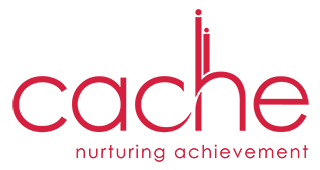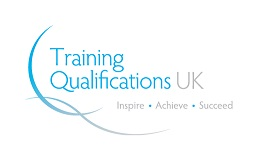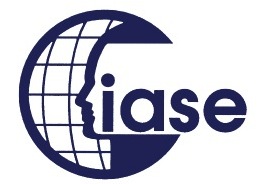ADHD And Tics: An Educator's Guide On How To Help A Child With Tics
13th April 2023

Research reveals that about 50% of the children diagnosed with ADHD have tics and between 35%-90% of the children with Tourette’s syndrome have ADHD or ADHD-like symptoms.
Supporting a child with a tic disorder largely involves reducing anxiety, shame, and other factors that aggravate and enforce tics. Even though it can be difficult at times, it is essential to understand tics so as to create a helpful and supportive environment for the child. If your child is diagnosed with ADHD and is wondering what tics have to do anything with ADHD, here is a quick explanation of the connection between ADHD tics, causes, and strategies to manage them.
Tics And ADHD: How Are They Related?
ADHD is a complex disorder with numerous symptoms and effects. While ADHD in itself does not cause tics, individuals with this often have a co-occurring tic disorder. It is also possible that ADHD is combined with another condition that has symptoms like tics.
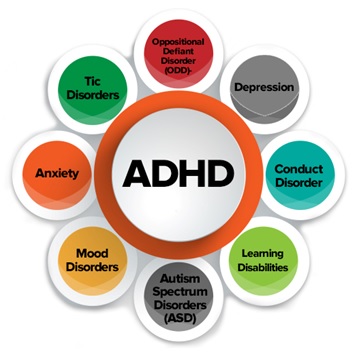
Source: health.ucdavis.edu
Several medical studies have shown that there is a possibility that certain types of ADHD medications can either cause or worsen tics.
Types Of ADHD Tics
Children with ADHD may have one or a combination of the following tics:
- Vocal Tics
These are involuntary sounds that children make with their voices. They sound fairly ordinary like coughing, throat clearing, sniffing, or coughing. It might also include unusual sounds like snorting, blurting out inappropriate words, or repeating words and phrases.
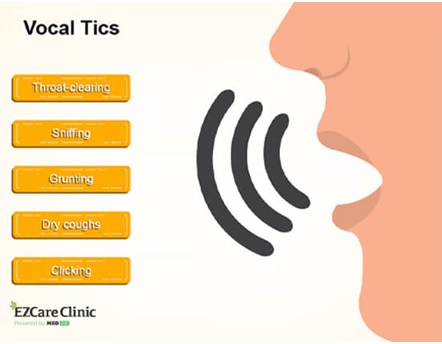
Source: ezcareclinic.io
It is often difficult to separate some vocal tics from other common ADHD symptoms as impulsivity is the core symptom of ADHD and it often leads to inappropriate interrupting. Children with ADHD might also interrupt the class or blurt out words without having any tic disorder.
- Motor Tics
Motor or movement tics are quite common in people with ADHD. They can be mild to excessive such as rigorous eye movements, shrugging, or blinking. Motor tics can also be quite noticeable with movements like facial grimacing, mouth opening, head movements, twitching, shoulder shrugging, or a combination of all of these movements.
Motor tics can be a serious problem if they become extreme and can distract others in the classroom or at work thus getting in the way of social interactions.
- Skin Picking
This includes scratching or picking skin to the point that it starts bleeding. When it becomes excessive, it can cause serious injury or infection. Skin picking often creates injuries that can be embarrassing to the point that individuals have to wear full sleeves and long trousers even in hot scorching summers.
Causes Of ADHD Tics
Genetics is a concerning factor that plays a significant role in the development of tics in people with ADHD, but it is not the only factor.
Here are some of the other causes of ADHD tics:
- Anxiety
Anxiety and depression can be one of the causes apart from genetics that causes tics in both children and adults. In most cases, treating depression and anxiety can reduce tics in ADHD. However, people with Tourette’s syndrome can also experience psychiatric issues that might make tics worse.
- ADHD Medications
Children with ADHD are often treated with medications known as stimulants. Even though there are some disagreements related to the connection between ADHD medications and tics, it does seem that certain medications can in rare circumstances cause tics, and changing or reducing the dosage can be a way to lessen or eliminate tics.
Ways To Manage Tics In Students With ADHD
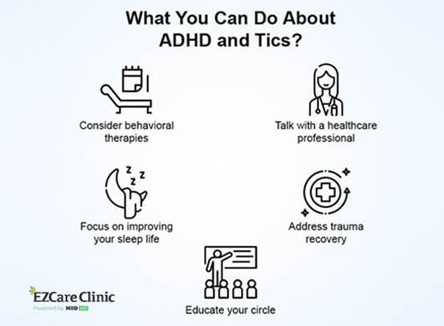
Source: ezcareclinic.io
Take a look at some of the ways to reduce tics within a classroom:
1. Anticipate Tic Triggers
Tics may worsen when students are engaged are certain social situations, activities, or unfamiliar settings. For many children, a full day of masking and suppressing can be a tic factor, while others might get aggravated by playing certain games or loud noises. Thus, if you want to reduce the tics in children, it is essential to first determine what is causing them.
2. Offer Proper Support
Since anxiety is extremely common in children with tic disorders teaching them stress and anxiety management strategies can be helpful. You can also offer proper support like considering proper seating arrangement in a classroom and observing that there is nothing distracting or aggravating the students.
Furthermore, no two students with a tic disorder have the same needs hence you need to be sure to work with the school management to identify the support networks that work best for them.
3. Behavioral Therapy
This is kind of a treatment that teaches students to reduce and manage their tics. It is guided by habit reversal which is considered to be one of the best forms of intervention. Allowing students to sit for behavioral therapy will enable you to identify their tics better and you can then develop the perfect strategy to break this habit.
4. Seek Medical Help
When nothing else works from your side, it is best to look for professional help. There are several medical treatments available for tic. However, none of them is without side effects and none of them can be thought to be the absolute cure.
Healthcare professionals often try to regulate blood pressure through certain stimulants that might reduce tics and have fewer side effects. However, if a child with ADHD has developed tics after starting a medication, then the healthcare provider might look to change or reduce the dose to manage tics.
Do What’s Best For Your Students
Tics associated with ADHD can be a serious problem if not diagnosed in the early stages. However, they are not always serious and in certain cases, it might not be necessary to take any action to cure tics until and unless it does not impact the quality of life. As a teacher with a qualification in Online Master of Arts in Education with Early Childhood and Special Education, you must be able to look into the behavioral conditions of the child and whether or not they require medicated treatment. Know when to reach out to a professional and do your best to guide the parents to take part in their child's well-being.





